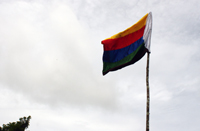Against All Odds: Experiences of IDP Self-Protection Measures in Colombia
After more than four decades of internal armed conflict, large-scale human rights
abuses, violence and drug wars, the displacement crisis in Colombia remains one of the
worst in the world.
Washington Office on Latin America
Introduction
Since 1985 more than four million Colombians have been displaced
from their homes and most have remained displaced. Colombia has developed some of
the most comprehensive laws and policies for addressing the protection and assistance
needs of the displaced and the international community has set up innovative internally
displaced person (IDP) programs. Despite such efforts, including improved IDP access to
humanitarian aid, most IDP needs and rights are far from being met or respected. This led
Colombia’s Constitutional Court to issue a groundbreaking ruling in April 2004 (T-025)
affirming that the state of affairs for IDPs in Colombia was unconstitutional. Since 2004
it has issued several orders to in an attempt to rectify this situation and as of October
2010, the Court has not lifted this state of unconstitutionality.
Of the numerous areas of concern identified in the orders of the Constitutional
Court and the non-governmental commission that monitors compliance of these orders,
the prevention of new displacement and the physical protection of civilians are two areas
that have seen the least compliance or success. While lack of security for IDPs has been a
constant concern since 1985, the country underwent some major transformations with the
support of billions of dollars of U.S. financing during President Alvaro Uribe’s two terms
in office, 2002-2010. Starting in 2006, one of the parties to the internal armed conflict,
the right-wing Self-Defense Forces of Colombia (AUC) began an extended process of
demobilization under what was called the Justice and Peace Framework. Also during his
tenure President Uribe instituted a hard line security strategy called the Democratic
Security Policy, which led to significant military gains against the left-wing
Revolutionary Armed Forces of Colombia (FARC), the dramatic military rescue of
French and U.S. hostages held in captivity for years by the guerillas, and the
militarization of much of the country.
While President Uribe’s security strategy is often lauded as a success2, it came at
a high human cost, with more than 21,000 combat deaths and over two million newly
displaced persons. The Colombian armed forces are currently under investigation for
having participated in more than 3,000 cases of extrajudicial killings, including cases
where army units killed civilians and then dressed them as rebels to inflate their body
counts. While an estimated 30,000 combatants demobilized within the Justice and Peace
Framework, the process was highly flawed in terms of truth, reparations and justice for
the victims. The mechanisms of the framework also failed to prevent paramilitary groups
from re-forming under different names. In Colombia, there remain an estimated 9,000
FARC and ELN guerillas and a similar number of new paramilitaries with names like the
2
Black Eagles, Gaitanistas and the New Generation (ONG). Lastly, Uribe’s presidency
was riddled by high level scandals. One of the most prominent was the para-politics
scandal, which saw more than 180 officials, mainly from Uribista coalition parties, come
under investigations for ties to the AUC. Another stain on the administration was the
Department of Administrative Security (DAS) scandal, whereby Colombia’s intelligence
agency illegally wiretapped and sabotaged the activities of court magistrates, journalists,
human rights defenders and others.
Prior to Colombia’s Uribe era and to this day, the Colombian state has not
adequately protected internally displaced communities. As such, many of these
communities were forced to come up with their own ways to shield themselves from
violent armed groups and drug traffickers. Colombian internally displaced communities,
returnees and communities at high risk of displacement have developed models of selfprotection
in order to prevent displacement and guarantee respect for civilians residing in
the midst of internal armed conflict. This paper describes the experiences of the IDP selfprotection
measures and civilian led efforts to prevent displacement known in Colombia
as “communities in resistance,” as well as self-protection efforts put into place by urban
IDPs. Included in paper are the experiences of IDPs in the San José de Apartadó Peace
community, the humanitarian and biodiversity zones in the Chocó, the Afro-Colombian
Yurumanguí River Mingas and the civilian rural campesino zones. The paper then goes
on to describe the security challenges faced by such efforts and offers steps that can be
taken by international and national entities in order to support these protection efforts.

